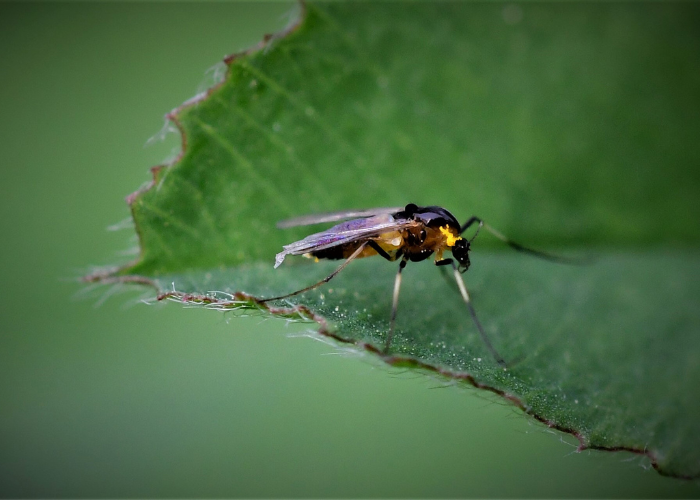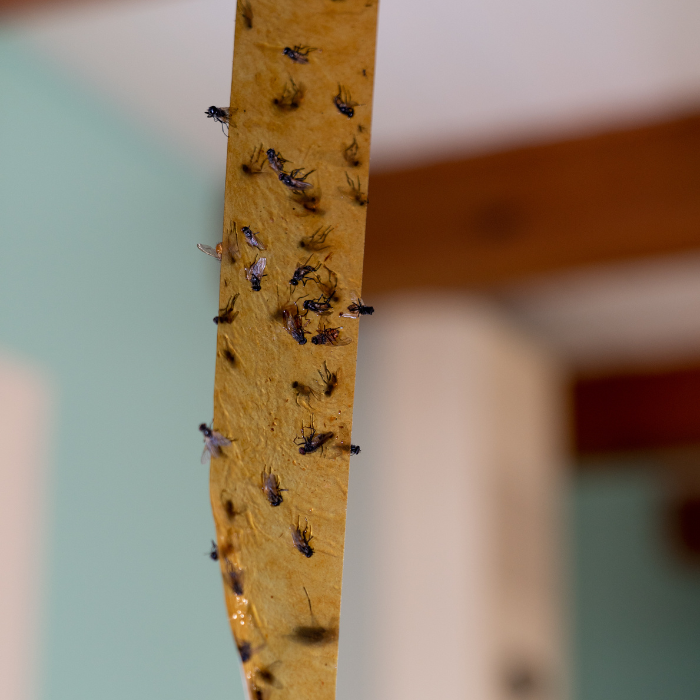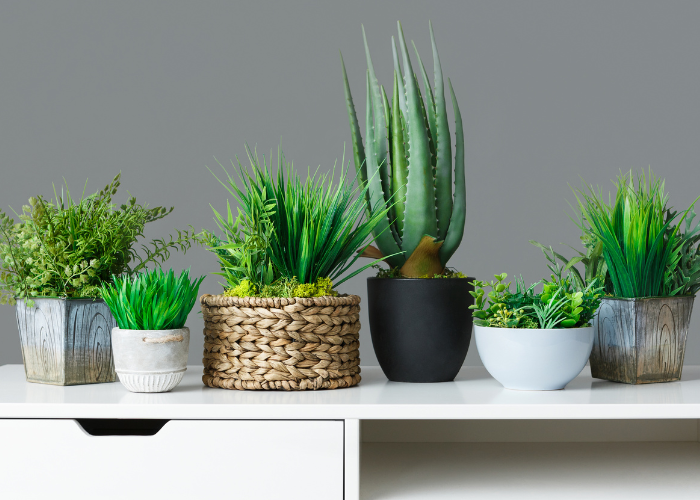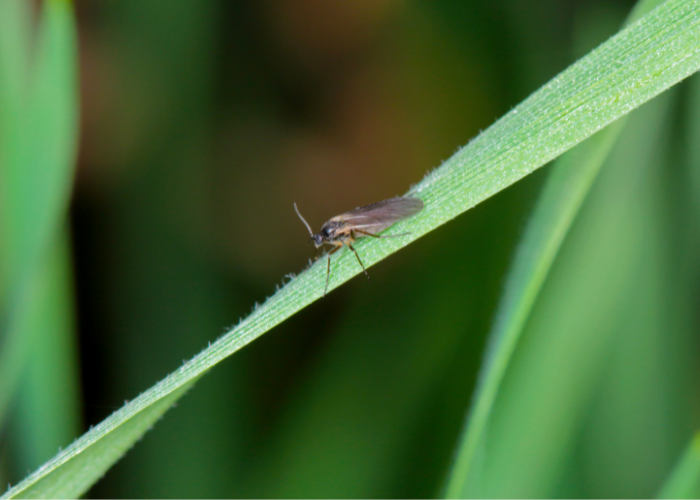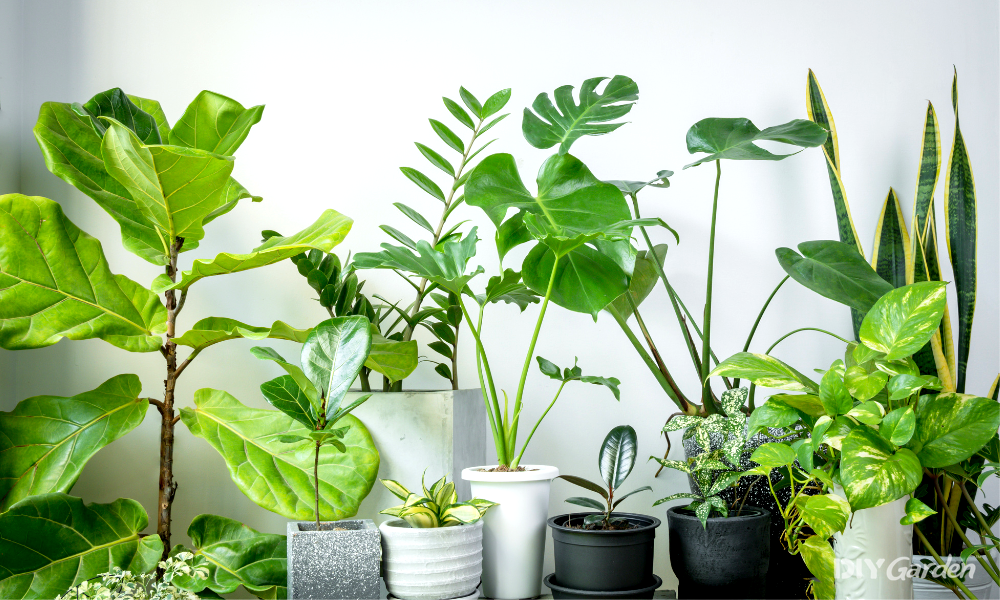
Tired of those pesky fruit flies and fungus gnats buzzing around your precious house plants? Worry not, because we have your back with all-natural solutions on how to get rid of fruit flies in house plants that will help you tackle these annoying pests head-on and maintain a healthy, pest-free home.
Key Takeaways
- Identify fruit flies & fungus gnats to effectively eliminate them.
- Use DIY traps, natural repellents and soil treatments to get rid of pests.
- Take preventative action by properly watering/draining plants, cleaning regularly & quarantining new plants.
Understanding Fruit Flies and Fungus Gnats
Fruit flies and fungus gnats are two common pests that can infest your house plants. While they may seem similar, it is crucial to distinguish between them to effectively tackle the problem.
Fruit flies are small, yellowish-brown insects with red eyes, attracted to ripe and overripe fruits, as well as moist, soggy soil. Fungus gnats, on the other hand, are slightly larger with a shiny black head and an elongated, whitish to transparent body. These gnats prefer damp compost and decaying plant material at the base of your indoor plants.
The primary causes of infestations include over-watering, poor drainage, and the introduction of new plants to your home without proper inspection. By understanding the reasons behind these infestations, you can take the necessary steps to prevent them and create a healthy environment for your plants to thrive.
Identifying Fruit Flies and Fungus Gnats
To spot fruit flies and fungus gnats, pay attention to their appearance and behavior.
Fruit flies are typically small with a yellowish-brown color and red eyes. Fungus gnats are slightly larger, about 3-4mm long, with a shiny black head and an elongated, whitish to transparent body.
While fruit flies are attracted to sweet smells like vinegar, wine, and yeast, fungus gnats are drawn to moist soil, carbon dioxide, and decaying materials like peat moss or compost.
Keep an eye out for slime trails, similar to those left by slugs and snails, in your indoor plants. If you spot these trails, it’s likely that fungus gnats are present. Fungus gnat larvae are quite small; about 1/4-inch in length. They have a shiny black head and an elongated, whitish to transparent body.
It’s essential to identify and differentiate between fruit flies and fungus gnats to implement the right elimination and prevention methods.
Causes of Infestations
The main causes of fruit fly and fungus gnat infestations in house plants include excessive watering, poor drainage, and introducing new plants into the home without proper inspection.
Overwatering your plants can lead to soggy soil, which is an ideal breeding ground for fungus gnats to lay their eggs. Poor drainage can also contribute to excess moisture in the soil, attracting these pests.
When bringing new plants into your home, it’s crucial to inspect them for any signs of insect infestations. Quarantining new plants for a few days to a couple of weeks can help prevent the spread of pests to your existing plants.
By addressing these causes, you can significantly reduce the risk of fruit fly and fungus gnat infestations in your house plants.
READ NEXT: How to Water Your Plants When You’re on Holiday
Effective Methods to Eliminate Fruit Flies and Fungus Gnats
Now that we’ve identified fruit flies and fungus gnats and understood the causes of infestations, it’s time to take action. The three most effective methods to eliminate these pests from your house plants are DIY traps, natural repellents, and soil treatments.
Let’s explore each of these methods in detail to help you reclaim your pest-free home.
DIY Traps
One of the simplest and most cost-effective ways to trap fruit flies is by using a mixture of apple cider vinegar, dishwashing liquid, and water.
Combine these ingredients in a small bowl or cup and place it near the infested plant. The sweet smell of the vinegar will attract the fruit flies, while the dish soap will break the surface tension of the liquid, causing them to drown.
Another effective method for trapping fruit flies and fungus gnats is using carnivorous plants, such as sundew plants or venus fly traps. These fascinating plants naturally attract and consume insects, providing an eco-friendly solution to your pest problem.
For a more hands-on approach, try the lint roller hack. After cleaning each plant, rip off a new sheet on the sticky roller to prevent the transfer of bug eggs from one plant to another. The sticky traps is particularly useful in preventing the spread of infestations when dealing with multiple plants.
READ NEXT: How to Make Your Venus Fly Trap Grow Big!
Natural Repellents
Essential oils like basil, peppermint, lavender, and lemongrass can act as natural repellents for fruit flies and fungus gnats. These oils not only deter pests but also provide a pleasant aroma in your home.
Apply a few drops of your chosen essential oil to a cotton ball or diffuser and place it near your house plants to keep the pests at bay.
Other natural repellents include predatory creatures like nematodes, predatory mites, and rove beetle larvae. These beneficial insects can help control fruit fly and fungus gnat populations by preying on their larvae.
By incorporating these natural repellents into your pest control strategy, you can effectively combat infestations without resorting to harsh chemicals.
Soil Treatments
Treating the soil of your house plants is an essential step in eliminating fruit fly and fungus gnat infestations.
One effective method is using hydrogen peroxide and water solutions. Mix one tablespoon of hydrogen peroxide with one cup of water and pour it into a spray bottle. Apply the solution to your plant leaves and soil every other day for a week, then once per week to kill the larvae of adult fungus gnats.
Another critical aspect of soil treatment is maintaining the right moisture levels. Allowing the top layer of soil to dry out between waterings can help reduce the chances of gnats laying eggs. Consider using a gravel mulch or a layer of sand on top of the compost to create a barrier between the gnats and the soil, making it less hospitable for them to lay their eggs.
When dealing with a severe infestation, you may need to repot your plants in fresh, pest-free soil. Be sure to sanitize the pot before reusing it and monitor the moisture levels closely to prevent future infestations.
Preventative Measures for a Pest-Free Home
Now that we’ve discussed how to eliminate fruit flies and fungus gnats effectively, let’s focus on prevention.
By implementing proper watering and drainage, regular cleaning and inspection, and quarantining new plants, you can maintain a healthy, pest-free environment for your beloved house plants.
Let’s explore these preventative measures in more detail.
Proper Watering and Drainage
Watering your house plants correctly is crucial in preventing fruit fly and fungus gnat infestations.
The best way to water your plants is to give them a thorough soak until you see water coming out of the pot’s drainage holes. However, be careful not to leave your plants sitting in water, as this can create a breeding ground for gnats.
Good drainage is equally essential in keeping your plants healthy and pest-free. Ensure your pots have sufficient drainage holes and use well-draining potting soil to prevent excess moisture from attracting gnats.
By maintaining proper watering and drainage practices, you can significantly reduce the risk of fruit fly and fungus gnat infestations in your house plants.
Regular Cleaning and Inspection
Establishing a regular cleaning and inspection routine for your house plants can help you spot potential infestations early and take appropriate action.
Use a damp cloth or sponge to wipe the leaves gently, give them a gentle spray of water, or use a dilute soap solution to clean your plants. Remember to avoid using baby wipes, as they may contain harmful chemicals.
Conducting regular inspections is crucial in detecting any signs of pests or diseases on the leaves and stems of your plants. By catching infestations early, you can take prompt action to eliminate the pests and prevent them from spreading to your other plants.
Quarantine New Plants
When introducing new plants to your home, it’s essential to quarantine them for a few days to a couple of weeks to prevent the spread of pests or diseases.
Keep the new plants separate from your existing plants and inspect them daily for any signs of pests or diseases on the leaves and stems.
Implementing a quarantine period for new plants not only helps prevent the spread of pests, but also allows you to monitor the health of the new plants and ensure they are acclimating well to their new environment.
READ NEXT: The UK’s Latest Houseplant Statistics
Addressing Common Concerns About Fruit Flies and Fungus Gnats
We understand that dealing with fruit flies and fungus gnats can raise some concerns and questions. In this section, we will address common concerns about these pests, including whether they harm plants, spread disease, and how long it takes to get rid of an infestation.
By understanding these aspects, you can take well-informed actions to protect your plants and maintain a healthy home environment.
Do Fruit Flies and Fungus Gnats Harm Plants?
While fruit flies do not cause any harm to houseplants, fungus gnats can damage the roots of younger plants, potentially stunting their growth.
It’s essential to identify the type of pest infesting your plants to implement the appropriate elimination and prevention methods.
If you notice that your plants are wilting or their leaves are curling up, this could be a sign of fungus gnat damage to the roots. In such cases, it’s crucial to take immediate action to eliminate the infestation and prevent further damage to your plants.
Can Fruit Flies and Fungus Gnats Spread Disease?
While fungus gnats are harmless to humans, fruit flies can spread germs and bacteria by transferring them from dirty surfaces to clean ones.
Fruit flies can transmit bacteria like salmonella, E. coli, and listeria, which can lead to food poisoning and, in severe cases, even require hospitalization and put lives in danger.
It’s essential to maintain proper cleanliness and hygiene in your home and around your plants to minimize the risk of disease transmission by fruit flies.
Regular cleaning and disposal of overripe fruits can help prevent fruit fly infestations and reduce the risk of spreading germs.
How Long Does It Take to Get Rid of an Infestation?
The time it takes to eliminate fruit fly and fungus gnat infestations depends on the severity of the infestation and the methods used to tackle it.
In general, it can take anywhere from a few days to a few weeks to get rid of these pests. Consistency and vigilance are crucial in addressing infestations, as it may take several treatments and continuous monitoring to ensure the pests are completely eradicated.
By implementing the elimination methods and preventative measures discussed in this blog post, you can effectively combat fruit fly and fungus gnat infestations in your house plants. Remember to be patient, as it may take some time to see the desired results.
Summary
In conclusion, fruit flies and fungus gnats can be an unwelcome nuisance in your house plants, but they can be effectively eliminated and prevented using natural, eco-friendly solutions.
By understanding the differences between these pests, implementing DIY traps, natural repellents, and soil treatments, and taking preventative measures like proper watering and drainage, regular cleaning and inspection, and quarantining new plants, you can create a thriving, pest-free indoor environment.
With knowledge, consistency, and a little patience, you can protect your beloved house plants and enjoy the beauty and tranquility of your indoor jungle, free from unwelcome invaders.
Frequently Asked Questions
What kills fruit flies in plants?
Fruit flies in plants can be killed with a peroxide spray. Mixing one tablespoon of peroxide with one cup of water and spraying onto the plant leaves and soil will kill the larvae, without causing any damage to your plant.
This is an easy and effective way to get rid of fruit flies in your plants. It is safe for both the plant and the environment, and it is safe for both the plant and the environment.
How do I get rid of flies in my potted plants naturally?
To get rid of flies in your potted plants, mix one tablespoon of peroxide with one cup of water and spray it onto plant leaves and soil. The solution won’t hurt the plant, but will kill any larvae present.
Give it a try once a week until you see that all the bugs are gone!
What is the best way to get rid of a fruit fly infestation?
The best way to get rid of a fruit fly infestation is to use apple cider vinegar, microwaving it to enhance its smell and placing it in an area with lots of flies.
Red wine vinegar can also be used, though it tends to be more expensive.
How to get rid of fruit flies?
Getting rid of fruit flies doesn’t have to be a challenge! Simply dispose of overripe fruits and veggies, keep food items stored in the fridge, clean up any spills quickly, and take out the garbage regularly to keep these pesky bugs away.
By following these simple steps, you can keep your home free of fruit flies and enjoy a pest-free environment.
